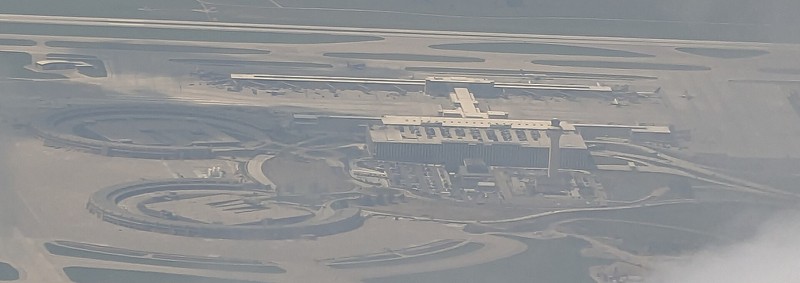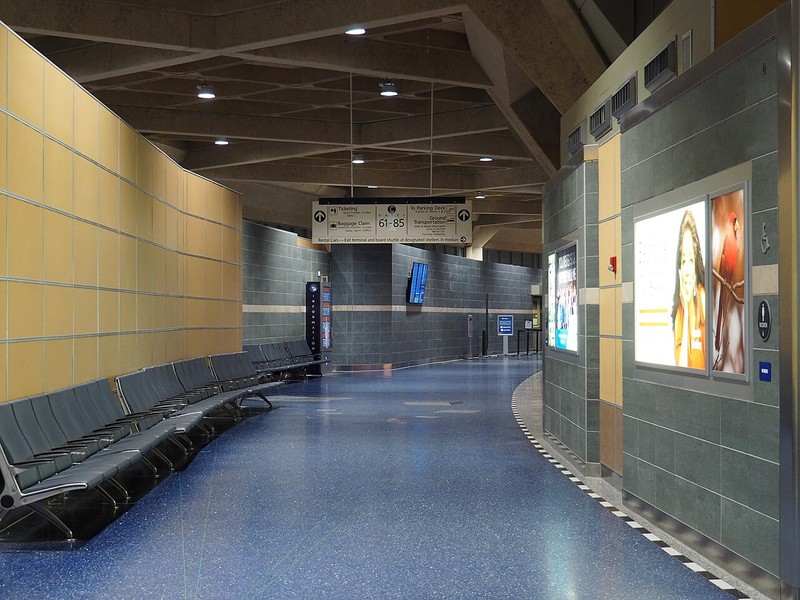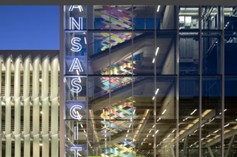This entry includes a walking tour! Take the tour.
Introduction
Author-Uploaded Audio
00:00 / 00:00
David Wayne Reed discusses the airport's public arts program and the way they included diverse Kansas City artists
Text-to-speech Audio
When Kansas City International Airport opened in 1972 at the former location of Mid-Continent Airport, it featured three curved terminals with gates that were only 75 feet from the roadway. With three runways and dozens of gates, along with the growth of Kansas City-based airlines like Braniff and TWA, residents were optimistic that their city would become one of the nation's largest airline hubs. Instead, the jet age made midwestern stopovers a thing of the past, and the airport's three terminals never reached their designed passenger capacity. With increased security measures, the once-convenient and car-centric three-terminal design proved untenable as it required multiple security checkpoints and passenger waiting areas. A new single terminal design was constructed between 2019 and 2023. The single terminal design eliminated the ability to "drive to your gate," a central selling point of the 1972 design. However, the new terminal makes it possible for travelers to move throughout the entire airport after passing through a central security checkpoint. The new terminal is also filled with work from local artists under the city's One Percent for Art program.
Images
Logo for Kansas City International Airport

The New Terminal features a central security checkpoint while two of the original circular terminals remain but are closed.


The new parking garage also includes artwork. This photo shows Flights by Hou de Sousa

Backstory and Context
Text-to-speech Audio
Promising the opportunity to "drive to your gate," many expected the novel design of the 1972 terminals at Kansas City International to become the standard. However, that same year, a series of hijackings led to the creation of security checkpoints at airports nationwide. Following additional security measures after the September 11, 2001 attacks, the slender circular design of the airport's three terminals required multiple security checkpoints. The need to divide the passenger terminals into a secured side and a side with security, check-in, and baggage claim limited airside passengers to a narrow corridor after passing through security. Kansas City officials began to explore the possibility of a new terminal with a central security checkpoint that would allow passengers to move throughout the airport after passing through security instead of being confined to a waiting area near their gate.
After several years of planning, a $1.5 billion single terminal plan was approved. During construction, MCI operated out of Terminals B and C while Terminal A was demolished to provide space for the new single terminal. Kansas City residents celebrated the completion of the largest construction project in the city's history in February 2023, with thousands touring the new terminal before its grand opening.
One Percent for Art Program and Public Art in Kansas City
As a public building, the new terminal was part of the city's "One Percent for Art" program, which requires that one percent of the total construction cost of a public building be dedicated to public art. The artwork commissioner for the new terminal and parking garage was installed in 2023. Those who take the tour of the airport in Clio can hear from many of the artists whose works are available on the post-security side of the airport along with those who were part of the effort to create the history exhibit. For example, the Clio entry within this tour for Leo Villareal's fountain includes an overview by David Wayne Reed, who helped select artists and works. From his perspective, this work and the city's program to support visual arts makes the terminal a public museum that also just happens to feature arrivals and departure.
The airport is one of numerous public buildings that incorporate public art. The 1925 city charter established a Municipal Art Commission to approve works within public buildings. That law also prohibits art from being removed from a public building without the approval of the commission. City ordinances passed in 1970 and 1992 created a fund to support art. In 1986, city leaders approved the One Percent for Art Program, which required one percent of the total cost of new construction and remodeling projects at city buildings to be set aside for public art. The new airport terminal incorporates a few works from the previous three terminals, including numerous terrazzo floors and tile medallions.
History of Aviation in Kansas City
The first powered flight in the metropolitan area occurred in 1909 when Charles Hamilton demonstrated his aircraft in a field within what is now Overland Park. Two years later, suburban developer and streetcar operator William Strang built a runway complete with hangars and a grandstand that later included a small aviation school. After World War I, several parts of the metropolitan area were home to airfields, and the city had eight schools or airfields by 1930. Kansas City's first public airport was dedicated in 1927 and operated as Municipal Airport at the present location of Charles B. Wheeler Downtown Airport. The dedication included a speech by famed aviator Charles Lindbergh. Lindbergh remained a key figure in Kansas City aviation, helping to map out the “Lindbergh Line” for airline Transcontinental Air Transport (TAT) in 1929, which offered a coast-to-coast, 48-hour route blending air and rail travel. TAT merged with Western Air Express, and the combined companies formed a new airline, which would become Transcontinental and Western Air. By the 1950s, the company changed its name to Trans World Airlines and was known globally as the "Airline of the Stars." TWA chose Kansas City for its new headquarters in 1931, thanks largely to the influence of Lindbergh and Lou Holland and the support of city leaders.
The years that followed saw the creation and expansion of nearby Fairfax Airport which operated across the Missouri River. Both airports were located near downtown Kansas City and were home to passenger service and military operations along with manufacturing and maintenance facilities. TWA’s maintenance overhaul base was located at Fairfax Airport. A 1951 flood damaged Fairfax Airport, while the location of Municipal Airport on a peninsula along the Missouri River limited the airport's potential to serve the larger aircraft of the coming jet age by the 1960s. By this time, Kansas City had become a base of operations for Trans World Airlines, which operated maintenance facilities at Platte County's Mid-Continent Airport. Braniff Airlines also used Mid-Continent as a hub while most other passenger flights flew from downtown's Municipal Airport. Following numerous concerns about the short runways at Municipal Airport, Kansas City voters approved a 1966 bond measure to vastly expand Mid-Continent Airport, which reopened as Kansas City International Airport in 1972.
Cite This Entry
Trowbridge, David J. and Clio Admin. "Kansas City International Airport." Clio: Your Guide to History. November 25, 2024. Accessed March 27, 2025. https://theclio.com/tour/2718/14
Sources
Julius A. Karash, Rick Montgomery, and Doug Weaver, TWA: Kansas City's Hometown Airline (Kansas City, MO: Kansas City Star Books, 2001).
George R. Bauer, A Century of Kansas City Aviation History: The Dreamers and the Doers (Kansas City, MO: Historic Preservation Press, 1999).
Jason Roe, Plane Speaking Kansas City Public Library. https://kchistory.org/week-kansas-city-history/plane-speaking
Public Art, Kansas City International Airport
KCMO Public Art, City of Kansas City website https://www.kcmo.gov/city-hall/departments/general-services/municipal-art-commission/kcmo-public-art
https://en.wikipedia.org/wiki/Kansas_City_International_Airport#/media/File:Kansas_City_International_Airport_New_Terminal_(53138168013)_(cropped).jpg

